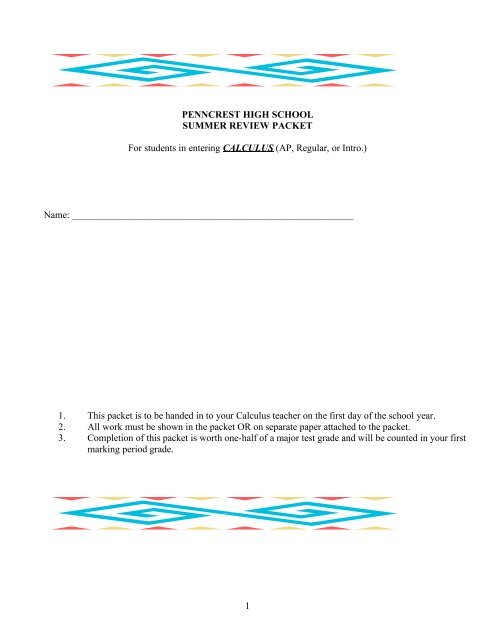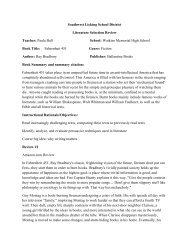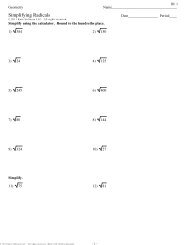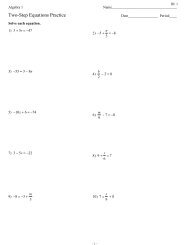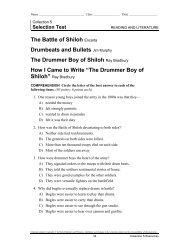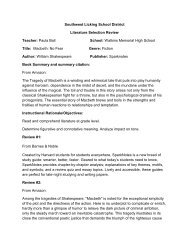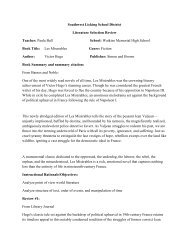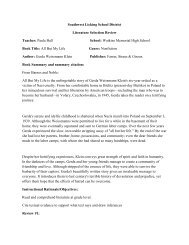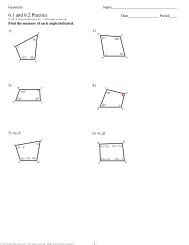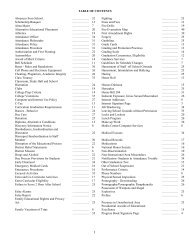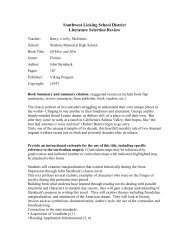1 PENNCREST HIGH SCHOOL SUMMER REVIEW PACKET For ...
1 PENNCREST HIGH SCHOOL SUMMER REVIEW PACKET For ...
1 PENNCREST HIGH SCHOOL SUMMER REVIEW PACKET For ...
- No tags were found...
Create successful ePaper yourself
Turn your PDF publications into a flip-book with our unique Google optimized e-Paper software.
<strong>PENNCREST</strong> <strong>HIGH</strong> <strong>SCHOOL</strong><strong>SUMMER</strong> <strong>REVIEW</strong> <strong>PACKET</strong><strong>For</strong> students in entering CALCULUS (AP, Regular, or Intro.)Name: __________________________________________________________1. This packet is to be handed in to your Calculus teacher on the first day of the school year.2. All work must be shown in the packet OR on separate paper attached to the packet.3. Completion of this packet is worth one-half of a major test grade and will be counted in your firstmarking period grade.1
Summer Review Packet for Students Entering Calculus (all levels)Complex FractionsWhen simplifying complex fractions, multiply by a fraction equal to 1 which has a numerator anddenominator composed of the common denominator of all the denominators in the complex fraction.Example:!7 ! 6x + 15x + 1=!7 ! 6x + 1 i x + 15 x + 1 = !7x ! 7 ! 65x + 1=!7x ! 135!2x +3xx ! 45 ! 1x ! 4=!2x +3xx ! 45 ! 1x ! 4x(x ! 4)!!i!!x(x ! 4)=!2(x ! 4) + 3x(x)5(x)(x ! 4) ! 1(x)=!2x + 8 + 3x25x 2 ! 20x ! x= 3x2 ! 2x + 85x 2 ! 21xSimplify each of the following.1.25a ! a5 + a2.2 ! 4x + 25 + 10x + 23.4 ! 122x ! 35 + 152x ! 34.xx + 1 ! 1 xxx + 1 + 1 x5.1! 2x3x ! 4x + 323x ! 42
Findf (x + h) ! f (x)hfor the given function f.17. f (x) = 9x + 3 18. f (x) = 5 ! 2xIntercepts and Points of IntersectionTo find the x-intercepts, let y = 0 in your equation and solve.To find the y-intercepts, let x = 0 in your equation and solve.Example: y = x 2 ! 2x ! 3x ! int. (Let y = 0)0 = x 2 ! 2x ! 30 = (x ! 3)(x + 1)x = !1 or x = 3x ! intercepts (!1,0) and (3,0)y ! int. (Let x = 0)y = 0 2 ! 2(0) ! 3y = !3y ! intercept (0,!3)Find the x and y intercepts for each.19. y = 2x ! 5 20. y = x 2 + x ! 221. y = x 16 ! x 2 22. y 2 = x 3 ! 4x4
Use substitution or elimination method to solve the system of equations.Example:x 2 + y ! 16x + 39 = 0x 2 ! y 2 ! 9 = 0Elimination Method2x 2 ! 16x + 30 = 0x 2 ! 8x + 15 = 0(x ! 3)(x ! 5) = 0x = 3 and x = 5Plug x=3 and x = 5 into one original3 2 ! y 2 ! 9 = 0 5 2 ! y 2 ! 9 = 0!y 2 = 0 16 = y 2y = 0 y = ±4Points of Intersection (5, 4), (5,!4) and (3,0)Substitution MethodSolve one equation for one variable.y 2 = !x 2 + 16x ! 39 (1st equation solved for y)x 2 ! (!x 2 + 16x ! 39) ! 9 = 0 Plug what y 2 is equalto into second equation.2x 2 ! 16x + 30 = 0 (The rest is the same asx 2 ! 8x + 15 = 0previous example)(x ! 3)(x ! 5) = 0x = 3 or x ! 5Find the point(s) of intersection of the graphs for the given equations.23.x + y = 84x ! y = 724.x 2 + y = 6x + y = 425.x 2 ! 4y 2 ! 20x ! 64y ! 172 = 016x 2 + 4y 2 ! 320x + 64y + 1600 = 0Interval Notation26. Complete the table with the appropriate notation or graph.Solution Interval Notation Graph!2 < x " 4!1,7) "#85
Solve each equation. State your answer in BOTH interval notation and graphically.27. 2x ! 1 " 0 28. !4 " 2x ! 3 < 4 29.x2 ! x 3 > 5Domain and RangeFind the domain and range of each function. Write your answer in INTERVAL notation.30. f (x) = x 2 ! 5 31. f (x) = ! x + 3 32. f (x) = 3sin x 33. f (x) = 2x ! 1InversesTo find the inverse of a function, simply switch the x and the y and solve for the new “y” value.Example:3f (x) = x + 1 Rewrite f(x) as y3y = x + 1Switch x and y3x = y + 1 Solve for your new y( x) 3 3= y + 1x 3 = y + 1y = x 3 ! 1( ) 3 Cube both sidesf !1 (x) = x 3 ! 1Find the inverse for each function.SimplifySolve for yRewrite in inverse notation34. f (x) = 2x + 1 35. f (x) = x236
Also, recall that to PROVE one function is an inverse of another function, you need to show that:f (g(x)) = g( f (x)) = xExample:If: f (x) = x ! 94and g(x) = 4x + 9 show f(x) and g(x) are inverses of each other.( ) ! 9"f (g(x)) = 4 x ! 9 %#$4 &' + 9 g( f (x)) = 4x + 94= x ! 9 + 9 = 4x + 9 ! 94= x = 4x4= xf (g(x)) = g( f (x)) = x therefore they are inversesof each other.Prove f and g are inverses of each other.36. f (x) = x32g(x) =32x37. f (x) = 9 ! x 2 , x " 0 g(x) = 9 ! x7
Equation of a lineSlope intercept form: y = mx + bVertical line: x = c (slope is undefined)Point-slope form: y ! y 1= m(x ! x 1) Horizontal line: y = c (slope is 0)38. Use slope-intercept form to find the equation of the line having a slope of 3 and a y-intercept of 5.39. Determine the equation of a line passing through the point (5, -3) with an undefined slope.40. Determine the equation of a line passing through the point (-4, 2) with a slope of 0.41. Use point-slope form to find the equation of the line passing through the point (0, 5) with a slope of 2/3.42. Find the equation of a line passing through the point (2, 8) and parallel to the line y = 5 6 x ! 1 .43. Find the equation of a line perpendicular to the y- axis passing through the point (4, 7).44. Find the equation of a line passing through the points (-3, 6) and (1, 2).45. Find the equation of a line with an x-intercept (2, 0) and a y-intercept (0, 3).8
Derivatives and Critical PointsUse the power rule to find the derivative for each of the following functions.Power Rule : Given f (x) = ax n , f '(x) = n ! ax n"1Example:f (x) = 3x 2 ! 5x + 7f '(x) = 6x ! 546. f (x) = 5x 4 ! 3x 2 + 2 47. f (x) = 6x 3 ! 5x 2 + 4x ! 2 48. f (x) = 2x + 449. f (x) = 7 50. f (x) = x 5 ! 2x 3 ! 5x + 4Find the slope of the line tangent to each of the following functions at the given point. Recall that thederivative of a function is a formula for the slope of the tangent line at any point along the function. Tofind the slope at a given point, use the power rule to determine the derivative and substitute the x-coordinate into the derivative.Example:f (x) = 4x 3 ! 2x + 1f '(x) = 12x 2 ! xat the point (1, 3), the slope of the tangent line isf '(1) = 12(1) 2 ! 1 = 1151. f (x) = x 4 ! 2x 3 + 5x 2 ! 8 at the point (-2, 44)52. f (x) = !x 2 ! x + 2 at the point (0.5, 1.25)9
Find the equation of the line in slope intercept form, tangent to the graph of each of the followingfunctions at the given point. Use the derivative as in the previous example to find the slope. Use the slopeand the given point to write the equation of the line tangent to the graph.Example:f (x) = x 2 ! 2x + 7 at the point (2, 7)f '(x) = 2x ! 2f '(2) = 2(2) ! 2 = 2y ! y 1= m(x ! x 1) or y = mx + by ! 7 = 2(x ! 2)7 = 2(2) + by = 2x + 3 y = 2x + 353. f (x) = !2x 2 + 3x + 10 at the point (1, 11)54. f (x) = 3x 3 ! 2x 2 + 4x ! 2 at the point (-2, -42)Find the critical numbers for each of the following functions. Critical numbers are the x-values for whichthe derivative is undefined or equal to zero. Find the derivative and set it equal to zero.f (x) = 2 3 x3 + 5 2 x2 ! 7xExample:f '(x) = 2x 2 + 5x ! 70 = (x ! 1)(2x + 7)Critical numbers: x = 1 or x = ! 7 255. f (x) = 3x 3 ! 9x + 5 56. f (x) = x 2 + 2x ! 1510
Determine the maximum or minimum value(s) of the function. First, find the critical numbers, then use asign chart to test whether a maximum value, a minimum value or neither exists at the critical number.Example:f (x) = x 3 ! 3x 2f '(x) = 3x 2 ! 6x0 = 3x(x ! 2)critical numbers: x = 0, x = 2Sign chart: f '(!1) > 0 f '(1) < 0 f '(3) > 00 2The sign of the derivative changes from positive to negative at x = 0, so we have a maximum at thepoint (0, 0). The sign of the derivative changes from negative to positive at x = 2, so we have a minimum at thepoint (2, -4).57. f (x) = x 2 ! 2x 58. f (x) = x 3 ! 12xRadian and Degree Measure180 !! radiansUse to get rid of radians and Use to get rid of degrees and! radians 180 !convert to degrees.convert to radians.59. Convert to degrees: a. 5! 6b. 4! 5c. 2.63 radians60. Convert to radians: a. 45 ! b. !17 ! c. 237 !11
Angles in Standard Position61. Sketch the angle in standard position.a. 11!6b. 230 ! c. ! 5" 3d. 1.8 radiansReference Triangles62. Sketch the angle in standard position. Draw the reference triangle and label the sides, if possible.a. 2 !! b. 2253c. ! " 4d. 30 !Unit CircleYou can determine the sine or cosine of a quadrantal angle by using the unit circle. The x-coordinate of thecircle is the cosine and the y-coordinate is the sine of the angle.2Example: sin90 ! = 1 cos ! 2 = 0(0,1)(-1,0)(1,0)(0,-1)- 212
63. a.) sin180 ! b.) cos270 !2(0,1)c.) sin(!90 ! )d.) sin!(-1,0)(1,0)e.) cos 360 ! f .) cos(!" )- 2(0,-1)Graphing Trig Functionsf( x) = sinx ( )2f( x) = cos( x)2- 5 5- 5 5- 2- 2y = sin x and y = cos x have a period of 2! and an amplitude of 1. Use the parent graphs above to help yousketch a graph of the functions below. <strong>For</strong> f (x) = Asin(Bx + C) + K , A = amplitude, 2! B = period,C= phase shift (positive C/B shift left, negative C/B shift right) and K = vertical shift.BGraph two complete periods of the function.64. f (x) = 5sin x 65. f (x) = sin2x#66. f (x) = ! cos x ! " &$%4 '( 67. f (x) = cos x ! 313
Trigonometric Equations:Solve each of the equations for 0 ! x < 2" . Isolate the variable, sketch a reference triangle, find all thesolutions within the given domain, 0 ! x < 2" . Remember to double the domain when solving for a doubleangle. Use trig identities, if needed, to rewrite the trig functions. (See formula sheet at the end of the packet.)68. sin x = ! 1 269. 2cos x = 370. cos2x = 1 271. sin 2 x = 1 272. sin2x = ! 3273. 2cos 2 x ! 1! cos x = 074. 4 cos 2 x ! 3 = 0 75. sin 2 x + cos2x ! cos x = 014
Inverse Trigonometric Functions:Recall: Inverse Trig Functions can be written in one of ways:arcsin ( x) sin !1 ( x)Inverse trig functions are defined only in the quadrants as indicated below due to their restricted domains.cos -1 x < 0 sin -1 x >0cos -1 x >0tan -1 x >0Example:Express the value of “y” in radians.sin -1 x
Example: Find the value without a calculator.!cos arctan 5 $"#6%&61Draw the reference triangle in the correct quadrant first. 5θFind the missing side using Pythagorean Thm. 6Find the ratio of the cosine of the reference triangle.cos! = 6 61<strong>For</strong> each of the following give the value without a calculator.!79. tan arccos 2 $"# 3%& 80. sec " 12%#$ sin!1 13&'!81. sin arctan 12 $"# 5 %& 82. sin " 7%#$ sin!1 8&'16
Circles and Ellipsesr 2 = (x ! h) 2 + (y ! k) 2(x ! h) 2+a 2(y ! k)2b 2 = 1Minor AxisbaMajor AxisCENTER (h, k)FOCUS (h - c, k) c FOCUS (h + c, k)<strong>For</strong> a circle centered at the origin, the equation is x 2 + y 2 = r 2 , where r is the radius of the circle.x 2<strong>For</strong> an ellipse centered at the origin, the equation isa + y2= 1, where a is the distance from the center to the2 2bellipse along the x-axis and b is the distance from the center to the ellipse along the y-axis. If the largernumber is under the y 2 term, the ellipse is elongated along the y-axis. <strong>For</strong> our purposes in Calculus, you will notneed to locate the foci.Graph the circles and ellipses below:83. x 2 + y 2 = 16 84. x 2 + y 2 = 54422- 5 5- 5 5- 2- 2- 4- 485. x21 + y29= 1 86.x216 + y24 = 14422- 5 5- 5 5- 2- 2- 4- 417
LimitsFinding limits numerically.Complete the table and use the result to estimate the limit.87.lim x " 4x!4 x 2 " 3x " 4x 3.9 3.99 3.999 4.001 4.01 4.1f(x)88.lim 4 " x " 3x!"5 x + 5x -5.1 -5.01 -5.001 -4.999 -4.99 -4.9f(x)Finding limits graphically.Find each limit graphically. Use your calculator to assist in graphing.89.lim cos x 90. lim 2x!0x!5 x " 591.lim f (x)x!1#f (x) = x2 + 3, x " 1$% 2, x = 1Evaluating Limits AnalyticallySolve by direct substitution whenever possible. If needed, rearrange the expression so that you can do directsubstitution.92. limx!2(4x 2 + 3) 93. limx!1x 2 + x + 2x + 194. limx!0x 2 + 495. limx!"cos x18
# x 2 " 1&96. limx!1 $%x " 1 '(x 2 + x " 6HINT: Factor and simplify. 97. limx!"3 x + 398. limx!0x + 1 " 1xHINT: Rationalize the numerator.3 " x99. limx!3 x 2 " 92(x + h) " 2x100. limh!0 hOne-Sided LimitsFind the limit if it exists. First, try to solve for the overall limit. If an overall limit exists, then the one-sidedlimit will be the same as the overall limit. If not, use the graph and/or a table of values to evaluate one-sidedlimits.101. limx!5 + x " 5x 2 " 25102. limx!"3 "xx 2 " 9103. limx!10 + x " 10x " 10#104. lim " 3 &x!5 " $%x + 5'(19
Vertical AsymptotesDetermine the vertical asymptotes for the function. Set the denominator equal to zero to find the x-value forwhich the function is undefined. That will be the vertical asymptote.105. f (x) = 1 x 2 106. f (x) = x 2x 2 ! 4107. f (x) = 2 + xx 2 (1! x)Horizontal AsymptotesDetermine the horizontal asymptotes using the three cases below.Case I. Degree of the numerator is less than the degree of the denominator. The asymptote is y = 0.Case II. Degree of the numerator is the same as the degree of the denominator. The asymptote is the ratio ofthe lead coefficients.Case III. Degree of the numerator is greater than the degree of the denominator. There is no horizontalasymptote. The function increases without bound. (If the degree of the numerator is exactly 1 more than thedegree of the denominator, then there exists a slant asymptote, which is determined by long division.)Determine all Horizontal Asymptotes.108.f (x) = x2 ! 2x + 1x 3 + x ! 7 109. f (x) = 5x3 ! 2x 2 + 84x ! 3x 3 + 5110. f (x) = 4x5x 2 ! 7Limits to InfinityA rational function does not have a limit if it goes to + ∞, however, you can state the direction the limit isheaded if both the left and right hand side go in the same direction.Determine each limit if it exists. If the limit approaches ! or " ! , please state which one the limit approaches.111.lim 1x!"1 x + 1 = 112. lim 2 + x+x!1 1" x = 113. lim 2+x!0 sin x =20
Reciprocal Identities: csc x = 1sin x<strong>For</strong>mula Sheetsec x = 1cos xcot x = 1tan xQuotient Identities:tan x = sin xcos xcot x = cos xsin xPythagorean Identities: sin 2 x + cos 2 x = 1 tan 2 x + 1 = sec 2 x 1 + cot 2 x = csc 2 xDouble Angle Identities:sin2x = 2sin x cos xtan2x =2 tan x1! tan 2 xcos2x = cos 2 x ! sin 2 x= 1 ! 2sin 2 x= 2cos 2 x ! 1Logarithms: y = log ax is equivalent to x = a yProduct property:Quotient property:Power property:Property of equality:log bmn = log bm + log bnlog bmn = log bm ! log bnlog bm p = p log bmIf log bm = log bn , then m = nChange of base formula:Derivative of a Function:Slope-intercept form: y = mx + bPoint-slope form: y ! y 1= m(x ! x 1)Standard form: Ax + By + C = 0log an = log n blog baf (x + h) # f (x)Slope of a tangent line to a curve or the derivative: limh!" h21


